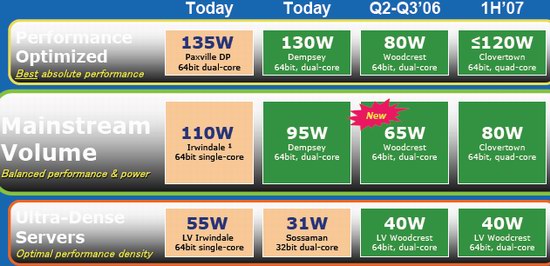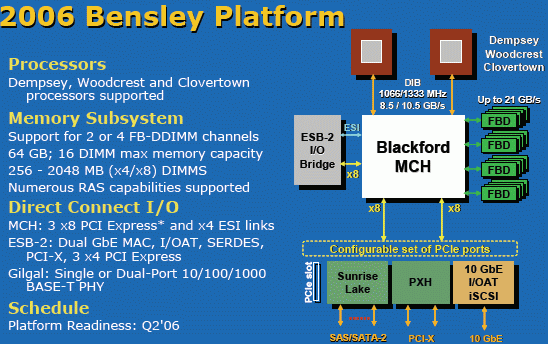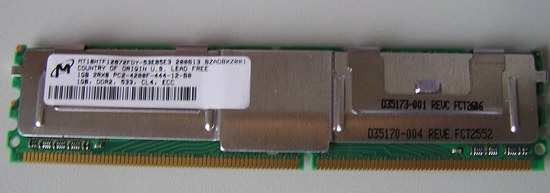Intel Woodcrest, AMD's Opteron and Sun's UltraSparc T1: Server CPU Shoot-out
by Johan De Gelas on June 7, 2006 12:00 PM EST- Posted in
- IT Computing
The New Intel Platform
The biggest advantage of Intel's newest Bensley platform is longevity: the Dempsey, Woodcrest and quad-core Clovertown Xeon all use the same socket and platform.

Bensley also eliminates the shared Xeon bus by giving each CPU an independent bus running at 1333 MHz. This is somewhat similar to the old Athlon MP platform, and it should be noted that this makes the Blackford Northbridge or MCH a pretty complex chip. Blackford also offers up to 4 memory channels and 24 PCI Express lanes.

The Dual Independent Bus (DIB) will not make much difference for Woodcrest and Dempsey as only some HPC applications are really limited by the FSB bandwidth. Three years of benchmarking tell us that most server and workstation application are not bottlenecked by the modern FSB speeds. The Opteron platform does not scale so much better thanks to NUMA in dual and quad core configurations. No, in most applications, the low latency integrated memory controller makes the difference, not FSB/NUMA bandwidth. Of course, with Clovertown, or two Woodcrests on one chip, a shared FSB might become a bottleneck, and in that case a DIB is a good idea.
The biggest innovation of Blackford is the introduction of fully buffered DIMMs (FB-DIMMs). On the FB-DIMM PCB we still find parallel DDR-2, but the Advanced Memory Buffer (AMB) converts this parallel data stream into a serial one to the Blackford chip. The serial links between the memory subsystem and the chipset not only eliminate skew problems but they also greatly simplify the routing on the motherboard. Routing quad-channel DDR-2 would be a nightmare.

The AMB, which you see under the heatsink in the middle of the DIMM, solves the skew and routing problems, and it comes with a relatively small price premium. The AMB also allows full duplex operation from the chipset to the AMB, where other memory bus designs are half duplex and introduce extra latency when alternating between send and receive modes. However, the AMB dissipates about 5 Watt and increases latency. This means that with 8 DIMMs or more, the advantage of using 65 Watt Woodcrest CPUs over 89-92 W Opterons will be gone.
The Blackford chipset uses X8 PCI Express links to talk to other various chips such as the ESB-2 I/O bridge, or "Southbridge" to keep it simple. The other PCI Express links can be used for 10 Gbit Ethernet or a SATA or SAS controller. A workstation version of Blackford, Greencreek will offer dual X16 PCI Express for running multiple workstation graphic cards.
The biggest advantage of Intel's newest Bensley platform is longevity: the Dempsey, Woodcrest and quad-core Clovertown Xeon all use the same socket and platform.

Bensley also eliminates the shared Xeon bus by giving each CPU an independent bus running at 1333 MHz. This is somewhat similar to the old Athlon MP platform, and it should be noted that this makes the Blackford Northbridge or MCH a pretty complex chip. Blackford also offers up to 4 memory channels and 24 PCI Express lanes.

The Dual Independent Bus (DIB) will not make much difference for Woodcrest and Dempsey as only some HPC applications are really limited by the FSB bandwidth. Three years of benchmarking tell us that most server and workstation application are not bottlenecked by the modern FSB speeds. The Opteron platform does not scale so much better thanks to NUMA in dual and quad core configurations. No, in most applications, the low latency integrated memory controller makes the difference, not FSB/NUMA bandwidth. Of course, with Clovertown, or two Woodcrests on one chip, a shared FSB might become a bottleneck, and in that case a DIB is a good idea.
The biggest innovation of Blackford is the introduction of fully buffered DIMMs (FB-DIMMs). On the FB-DIMM PCB we still find parallel DDR-2, but the Advanced Memory Buffer (AMB) converts this parallel data stream into a serial one to the Blackford chip. The serial links between the memory subsystem and the chipset not only eliminate skew problems but they also greatly simplify the routing on the motherboard. Routing quad-channel DDR-2 would be a nightmare.

The AMB, which you see under the heatsink in the middle of the DIMM, solves the skew and routing problems, and it comes with a relatively small price premium. The AMB also allows full duplex operation from the chipset to the AMB, where other memory bus designs are half duplex and introduce extra latency when alternating between send and receive modes. However, the AMB dissipates about 5 Watt and increases latency. This means that with 8 DIMMs or more, the advantage of using 65 Watt Woodcrest CPUs over 89-92 W Opterons will be gone.
The Blackford chipset uses X8 PCI Express links to talk to other various chips such as the ESB-2 I/O bridge, or "Southbridge" to keep it simple. The other PCI Express links can be used for 10 Gbit Ethernet or a SATA or SAS controller. A workstation version of Blackford, Greencreek will offer dual X16 PCI Express for running multiple workstation graphic cards.










91 Comments
View All Comments
Questar - Thursday, June 8, 2006 - link
Why? Because AMD got creamed?ashyanbhog - Thursday, June 8, 2006 - link
and Intel woodcrest may have fantastic performance when compared to earlier xeons,but Intel is 3 years late to the party, Opteron was here in 2003!
also remember, woodcrest is a brand new design from PIII base, manufactured on 65nm process. It is still to make its debut in the market and be available in volumes. Amd its indeed nice to see it being compared to a 3 year old design manufactued on 90nm process.
AMD still has two product launches to come this year. Move to DDR2 for opterons which should cut some power usage for the total system AND introduction of products manufactured on 65nm at the fag end of the year. Will woodcrest and conroe still retain their performance margins then? if not, for how many months or weeks has Intel grabbed this "performance crown"?
zsdersw - Thursday, June 8, 2006 - link
Consider the following:- If comparisons could be made between new products from both companies (i.e., Woodcrest versus K8L), they would be made. In the game of leapfrog that we have betweeen AMD and Intel, the comparisons will always be between existing tech and new tech. Will you be pointing out how AMD is "late to the party" when they release their new stuff?
- Making its debut and availability in volume is an issue for both AMD and Intel. It's not a valid point unless you make it across the board.
- 65nm will allow clock speeds of Opterons/A64's to increase.. but Conroe/Woodcrest speeds will be increasing as well.
ashyanbhog - Thursday, June 8, 2006 - link
not because AMD got creamed!a 35 billion$ dollar turnover company (Intel) is bound to make a comeback one day.
it Anandtech's review setup, its full of holes
the mysql benchmark on Dual Dual core opterons where they see a 30% drop against single core dual processor numbers in this becnhmark contradicts their own earlier benchmark where they see a 10% performance increase.
http://www.anandtech.com/IT/showdoc.aspx?i=2447&am...">http://www.anandtech.com/IT/showdoc.aspx?i=2447&am...
they also use a substandard MSI motherboard in one of the Opteron systems and fail to mention which system was used for the benchmarks
mistakes like this, genuine or intentional, are rife throughout the review report
the whole thing looks like the rig was setup to push the performance diff b/w woodcrest and Opterons to the max,
why would anybody two months to tweak settings before they publish the review!
Questar - Thursday, June 8, 2006 - link
Why? Because AMD got creamed?duploxxx - Thursday, June 8, 2006 - link
yeah right its a workstation motherboard it uses an nforce controller so maybe they rate it as server board it still is a budget board used for workstations, not a real server board or server chipset like they used on the intel woodcrest.check the servers like sun galaxy and hp dl385 they have amd chipsets... big difference.
the nforce has a shared memory bus...
zsdersw - Thursday, June 8, 2006 - link
Yeah, that's one of the 3 Opteron servers. At any rate, the MSI board is a basic server board.. it's still a server board.duploxxx - Thursday, June 8, 2006 - link
yeah they have done 1 real bench with an hp. all other benches were done with the 2 MSI basic boards...still waiting for the wintel benches
wolaris - Thursday, June 8, 2006 - link
In corporate environments, no-one with any hardware budget at all runs webserver and database on the same machine, as it hurts both performance and reliability. This affects T1 most, as its low clock speed and simple cores are not meant for database workloads.I think that you should run web serving tests using common, high-performance Opteron DB server and separate webservers, as it would be the case in real-world scenarios.
MrKaz - Thursday, June 8, 2006 - link
So Power consuming of the new Intel processor on .65nm at already high clock speed of 3.0Ghz is already consuming more than the older AMD Opteron on .90nm 2.8Ghz and DDR.When AMD releases socket F will go DDR2 (less power) and better .90nm samples (lower power). So then "new" Intel is already getting beaten...
And those tests where done with Cool&Quite?
Also don’t forget this tests where done with Woodcrest 3.0Ghz VS Opteron 2.2Ghz and 2.4Ghz, so when AMD releases the 2.8Ghz and 3.0Ghz with socket F the performance lead of Intel will vanish…
I think the biggest surprise here is how bad Xeon (P4) was (IS!!), and people keep buying it.